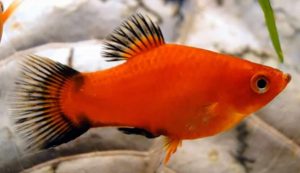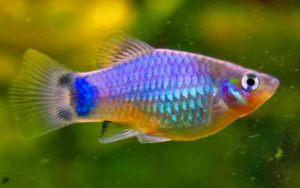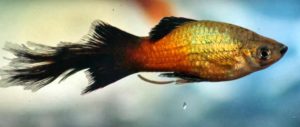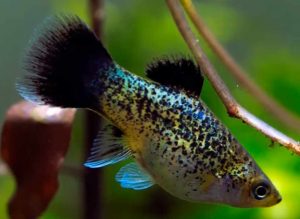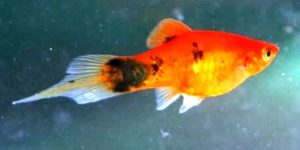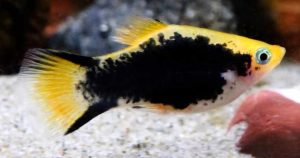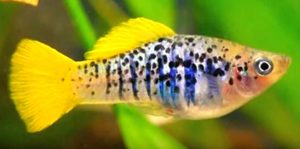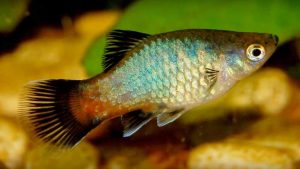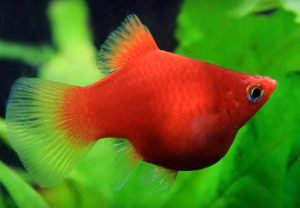The Common Platy (Xiphophorus maculatus), also known to tropical fish keeping enthusiasts as the Moonfish, Southern Platyfish, or Mickey Mouse Platy is native to North and Central America, but is also found in Belize and Central Mexico.
Platys share similar habitats with, and are closely related to Green Swordtails, which they will readily interbreed with when given the opportunity. They are both found in ponds, canals, slow moving streams, backwaters, and even drainage ditches throughout their range.
The Platy is an easy to care for livebearer that comes in a plethora of color and fin variations, with the most common being a brilliant solid red, and like some other livebearers, is considered an invasive species in several countries.
Wild Xiphophorus maculatus are drab in color and lack the distinctive dark lateral line that is common to many Xiphophorus species, but breeders have developed a multitude of color varieties for the aquarium trade that commonly includes orange, red, scarlet, yellow, red/black, black/white, blue, etc.
Some of the more common Platy variations include the Wagtail, Blue, Simpson Tuxedo, and Simpson Coral Platy.
Female Southern Platyfish have a fan shaped anal fin and grow to a maximum size of 2.5 inches.
Although sexual dimorphism is slight, the caudal fin of the male is more pointed and the anal fin has evolved into a stick shaped gonopodium, which is used for reproduction. Females are usually larger than males and both sport the same bright color patterns.
The males are almost always more brightly colored than the females. Wild specimens of both sexes posses a distinctive dark lateral line.
All Platys are omnivorous and in their natural habitat forage on algae, plant matter, small insects, worms, mosquito larvae, and crustaceans.
The Common Platy is a hardy, easy to keep species that is perfect for beginning tropical fish keeping enthusiasts.
They are best housed in a densely planted, well maintained aquarium of at least 10 gallon capacity, with a gravel substrate, some driftwood, river rocks, and hardy plants like Java Fern
or Java Moss
for the young to hide among. They are peaceful livebearers that can be housed with many other peaceful species
The Common Platy (Xiphophorus maculatus) is extremely easy to breed in a pond or aquarium environment and is capable of reproducing when they are only three or four months old.
Nothing special is required to trigger breeding activity, just make sure you have a larger ratio of females to males in the breeding tank or community aquarium. Two or three females to every male will be just fine and when they begin to breed, the males will constantly try to breed with every female in the tank.
For this reason, it’s a good idea to place them in larger quarters with Java Moss for them to hide among. When confined, the males continual advances will often stress out individual females to the point of death.
Once a female is impregnated, her belly will quickly swell and a dark gravid spot will appear near the anal fin. The dark spot is actually the dark eyes of the fry pressing against the interior of the female’s belly.
After the female gives birth to the young, remove either the fry or the parents to a rearing tank. Platys will quickly eat their young, which is why lots of cover is needed in a community tank if you plan to keep them together and save a few. Water Sprite, Cabomba, Java Moss, etc. will give the fry a place to hide in and a fighting chance of survival.
You need to have a plan to deal with the continuous supply of babies you will undoubtedly acquire when keeping Platys. A 30 gallon or larger tank will allow the plentiful supply of fry to grow to adulthood without overcrowding. You can then give them away, trade, or sell them.
Like most livebearers, the newly born fry are pretty well developed, so no special fry food is needed. They are able to eat powdered flake food as well as live, frozen, or freeze dried baby brine shrimp, microworms, daphnia, microworms
, When housed in a large tank they will grow quickly and
As adults, Platys do well on commercially prepared omnivore flakes, spiurilina flakes and live, frozen, or freeze dried bloodworms, blackworms, tubifex, daphnia
, brine shrimp, Drosophila fruit flies, and mosquito larvae.
Most varieties are readily available from tropical fish keeping shops or online when they are 3/4″ to 1-1/2″ in length at reasonable prices.
Minimum Tank Size: 10 gallons
Care Level: Moderate
Temperament: Peaceful
Hardiness: Moderately Hardy
Water Conditions: 64-79° F, KH 10-25, pH 7.0-8.5
Max. Size: 2 1/2″
Color Form: Assorted, Orange, Red, Yellow
Diet: Omnivore
Compatibility: Peaceful Community Tanks
Origin: North and Central America
Family: Poeciliidae
Lifespan: 3 years
Aquarist Experience Level: Beginner

